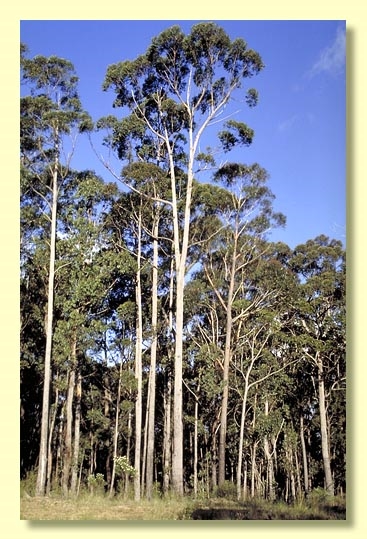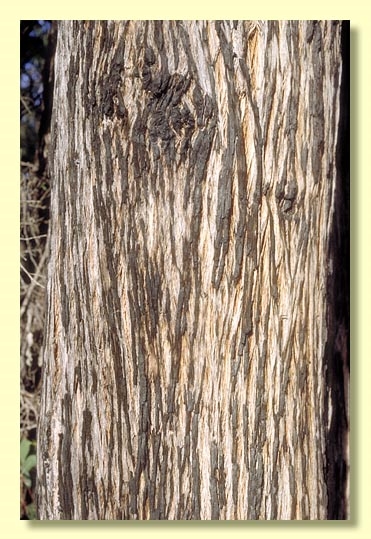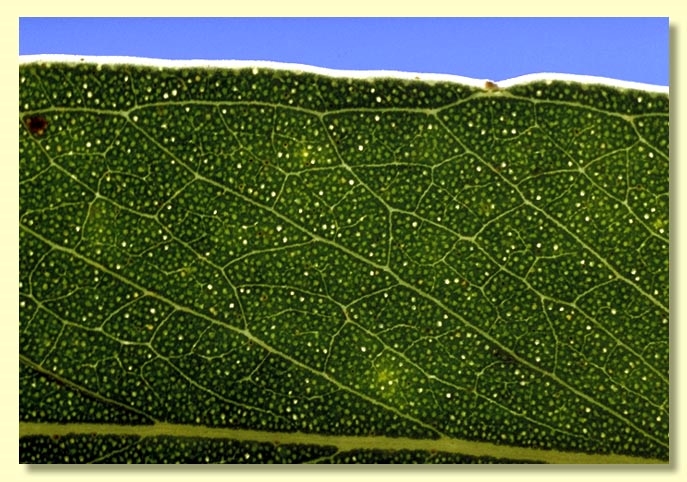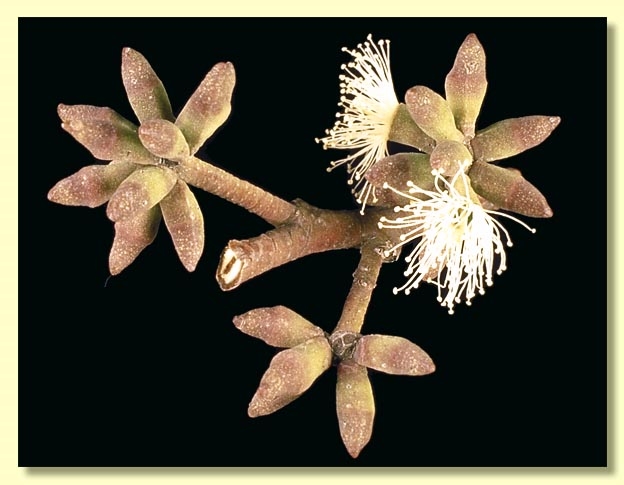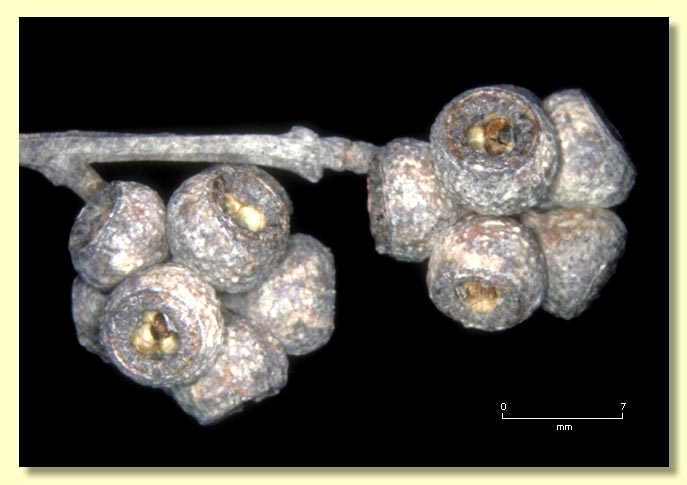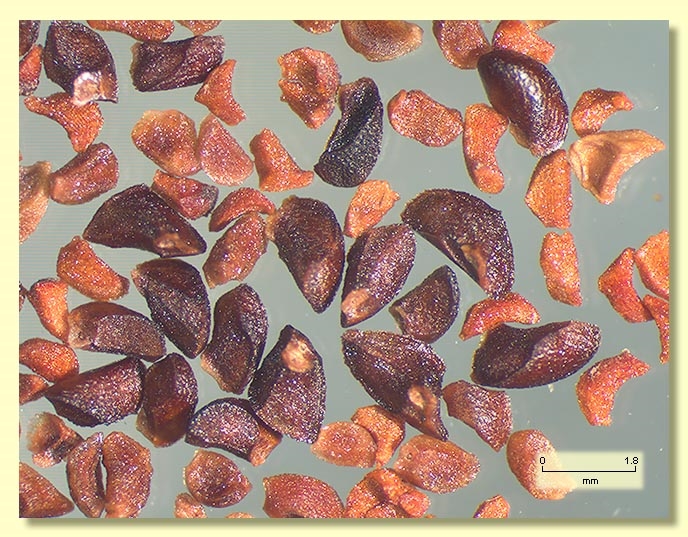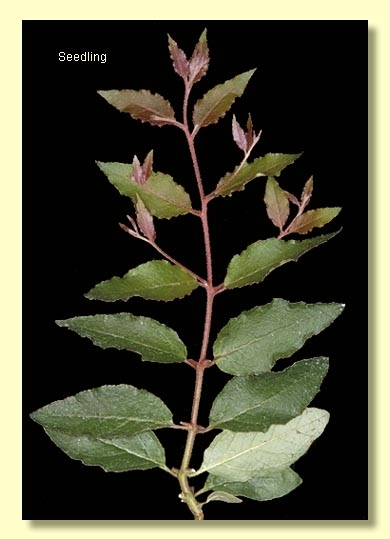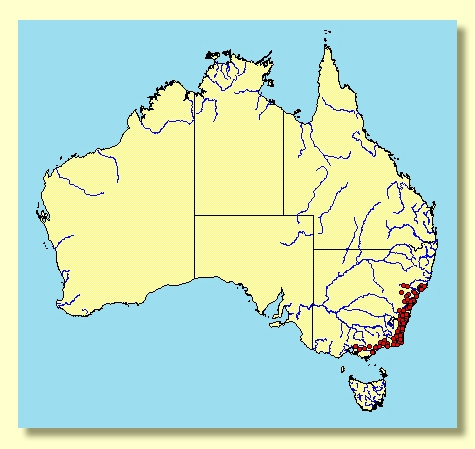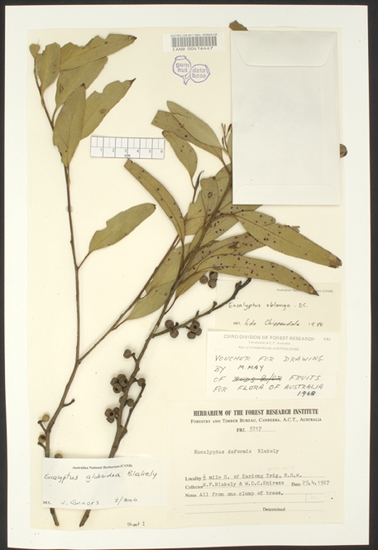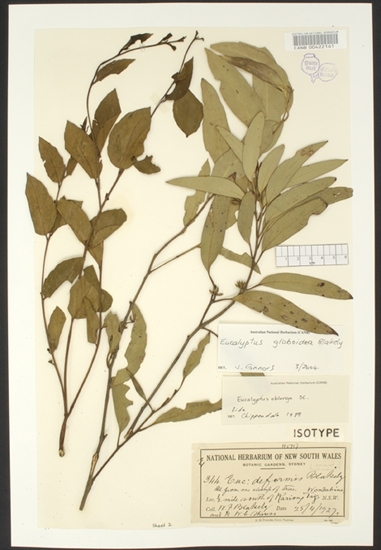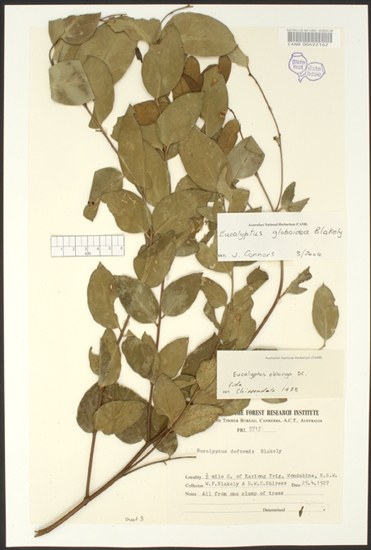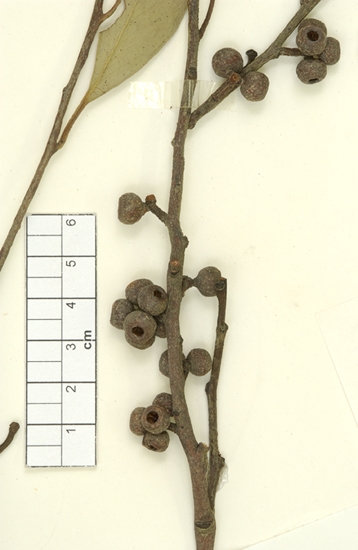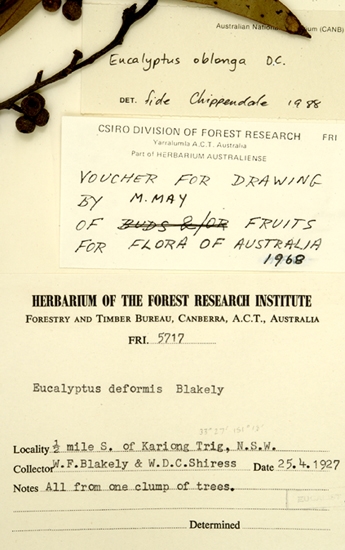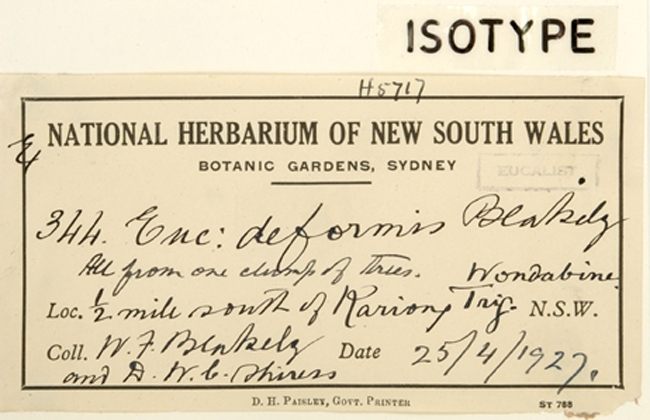Euclid - Online edition
Eucalyptus globoidea
Eucalyptus | Eucalyptus | Capillulus | Pachyphloius
T: Berrima, NSW, Sept. 1901, J.H.Maiden & J.L.Boorman s.n.; holo: NSW.
Eucalyptus oblonga DC., Prodr. 3: 217 (1828), in part (see comment below). T: New Holland, 1823, F.W.Sieber 583; holo: G; iso: BM, G, NSW.
Eucalyptus deformis Blakely, J. & Proc. Roy. Soc. New South Wales 61: 152 (1927). T: 0.8 km S of Kariong Trig., NSW, 25 Apr. 1927, D.W.C.Shiress & W.F.Blakely s.n.: holo: NSW; iso: CANB, K. (see image of type specimen held at CANB)
Eucalyptus oblonga var. rugulosa Blakely, Key Eucalypts 191 (1934). T: Spring Gully Ck, Hornsby, NSW, Oct. 1930, W.F.Blakely s.n.; holo: NSW.
Eucalyptus yangoura Blakely, Key Eucalypts 180 (1934). T: Macalister R., Vic., A.W.Howitt s.n.; syn: NSW; source of Wild Horse Ck, Vic., A.W.Howitt s.n.; syn: NSW; Toongabbie, Vic., A.W.Howitt s.n.; syn: NSW; Wangarabelle, Vic., Nov. 1914, H.Hopkins s.n.; syn: NSW; Bruthen, Vic., 1905, A.W.Howitt s.n. ; syn: NSW; Bruthen, Vic., 15 Jan. 1913, R.H.Cambage 3673; syn: NSW; Mt Lookout, Bairnsdale, Vic., 12 May 1908, H.Hopkins s.n. ; syn: NSW; Bairnsdale, Vic., 1905, A.W.Howitt s.n.; syn: NSW; Metung, Vic., July 1908, J.H.Maiden s.n.; syn: NSW; Agnes Bridge, Vic., A.W.Howitt s.n.; syn: NSW; Story Ck, Vic., no collector given; syn: MEL; Nicholson R., Vic.; syn: Walhalla, Vic., syn; Ringwood, Vic.; syn; Wyndham, NSW, Feb, 1903, A.W.Howitt s.n. ; syn: NSW; Cobargo, NSW; syn; Eden, NSW; syn; but several specimens in NSW labelled 'TwofoldBay'.
Eucalyptus globoidea var. subsphaerica Blakely, Key Eucalypts 189 (1934). T: Lane Cove, NSW, 6 July 1889, J.H.Maiden s.n.; syn: NSW; Wyee, NSW, Oct. 1920, J.L.Boorman s.n; syn: NSW.
Bark rough to small branches, stringy, furrowed down trunk, usually grey.
Juvenile growth (coppice or field seedlings to 50 cm): stem rounded in cross-section, scabrid; juvenile leaves always petiolate, opposite for a few pairs then alternate, usually ovate, 4–10 cm long, 2–4.5 cm wide, margins undulate and often irregular due to stellate hairs, discolorous, glossy, green; scabrid on growing tips, stems, petioles and both leaf surfaces for many pairs.
Adult leaves alternate, petiole 0.7–1.7 cm long; blade ovate to lanceolate to falcate, 7–13.5 cm long, 1.2–4 cm wide, base usually oblique, concolorous or slightly discolorous, glossy, green, side-veins usually acute, sparsely to moderately reticulate, intramarginal vein parallel to and well removed from margin, oil glands island.
Inflorescence axillary unbranched, peduncles 0.4–1.5 cm long, buds in umbels of 11 to 15, sessile or on pedicels 0.l–0.3 cm long. Mature buds ovoid to fusiform, 0.4–0.6 cm long, 0.2–0.4 cm wide, green to yellow, smooth, or slightly warty, scar absent, operculum conical, stamens irregularly flexed, anthers reniform to cordate, versatile, dorsifixed, dehiscing by confluent slits (usually), style long, stigma tapered, locules 3 or 4, the placentae each with 2 vertical ovule rows. Flowers white.
Fruit usually sessile, rarely with pedicels 0.1 cm, hemispherical or truncate-globose, 0.4–0.7 cm long, 0.5–0.8 cm wide, disc level or descending obliquely, valves 3 or 4, near rim level or enclosed.
Seeds blackish or brown, 1.2–2.5 mm long, pyramidal or obliquely pyramidal, dorsal surface smooth, hilum terminal.
Cultivated seedlings (measured at ca node 10): cotyledons reniform; stems rounded in cross-section, stellate-hairy; leaves at least shortly petiolate, opposite for 5 or 6 nodes (rarely more) then alternate, ovate to lanceolate, 3.5–10 cm long, 1.7–4.5 cm wide, base rounded to tapering, margin undulate, apex pointed, discolorous, mid-green above, paler beneath, moderately stellate-hairy on both surfaces.
Flowering has been recorded in January, February, July, August, September, October, November and December.
A small to medium-sized stringybark tree widely distributed in coastal ranges from eastern Victoria to the Central Tablelands and North Coast of New South Wales north to Woolgoolga. It occurs on infertile white sandy soils. Eucalyptus globoidea has stringy bark to the smaller branches, glossy green concolorous adult leaves, fusiform buds, and crowded truncate-globose but not laterally compressed fruit, usually with a descending disc. Juvenile leaves are ovate and scabrid for many pairs.
Within its natural range E. globoidea is fairly distinctive especially with its small fruit. Other species of stringybark likely to be confused are: E. agglomerata, which has a bluish green crown and more flattened fruit so tightly clustered the sides are compressed; E. baxteri, which has wider, thicker leaves, larger and slightly warty buds and larger fruit with an ascending disc; E. blaxlandii, which has smooth branches and buds with blunt opercula; E. muelleriana, which has pedicellate, obovoid buds with blunt operculum and larger pedicellate fruit; E. eugenioides, which differs in its thin-textured adult leaves and more pedicellate buds and fruit; E. imitans, which has longer buds that are often scurfy or slightly warty, and larger fruit.
E. globoidea as treated here includes the broader-leaved stringybark specimens previously included under E. oblonga, with the narrower-leaved specimens being included in E. tenella.
E. yangoura is also included in synonymy with E. globoidea as it seems to differs from the latter only in the steepness of the descending disc of the truncate-globose fruit. Disc position is often variable, from slightly raised to level to obliquely descending.
MORE ABOUT STRINGYBARKS

